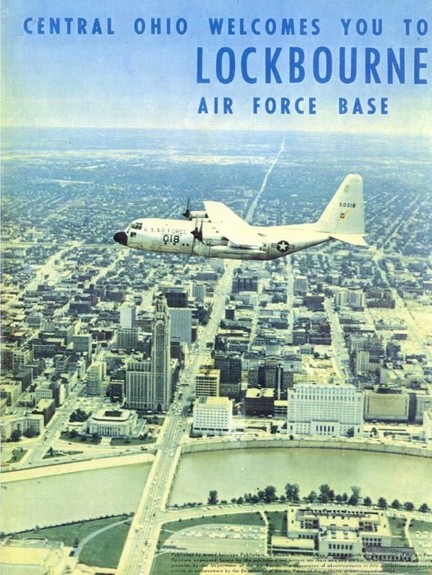Lockbourne Air Force Base
Introduction
Text-to-speech Audio
The base was established in 1942 as a training center for the Army Air Corps. It was home for several squadrons which included the Tuskegee Airmen's 477th Squadron group. During the outbreak of the Korean War, the base doubled in size. The base was renamed Rickenbacker Air Force base in 1974 to honor the World War 1 ace Eddie Rickenbacker.
Images
courtesy of Ohio Exploration Society

Courtesy of Ohio Exploration Society

http://www.usaf317thvet.org/lockbourne2.html

A postcard displaying a C-130 courtesy of Pinterest

Backstory and Context
Text-to-speech Audio
Lockbourne Air Force Base, formerly known as the Northeast Training Center of the Army Air Corps, is located in Franklin and Pickaway counties, 12 miles southeast of Columbus. The base has had many names over the years. In 1942, the base was named for the nearby town of Lockbourne. From 1942 through 1948, Lockbourne Army Air Base was used to train B-17 and glider pilots. It also housed the 55th Fighter Wing, which was established in 1947. The 55th Fighter Wing converted P-51 Mustangs to F- 84C Thunderjets. Benjamin O. Davis, a famous Tuskegee Airman during World War II, served as the base commander. Davis was the first African-American to receive the rank of General. Because of the many changes that were made, including the establishment of the United States Air Force in 1947, it was renamed Lockbourne Air Force Base.In 1951, the name changed again, this time to Strategic Air Force Command Base. The Strategic Air Command (SAC) played a major role for the U.S. Air Force until 1992. In 1951, SAC Base housed the 91st Bomb Wing, which became a long-running program. In 1955, the 70th Strategic Reconnaissance, Medium was also housed at the SAC base.The advancement in technology helped change how things occurred. In 1953, the 301st Bomb Wing received the advanced B-47 Stratojet bomber. In addition, they replaced the KB-29 tankers with KC-97 tankers, a reflection of the use of advanced technology. The tankers were transferred from Barksdale Air Force Base to Lockbourne AFB on April 15, 1955. The tankers had upgrades in electronics, a significant technical advancement for the U.S. Air Force. The B-47 Stratojet bomber was last used in 1964 because it was replaced by the KC-135 as an air refueling wing, a sign of the change in technology.In 1974, Lockbourne Air Force Base was renamed Rickenbacker Air Force Base after former racecar driver and pilot Eddie Rickenbacker, who was from the area. In 1991, the base was supposed to close, but the state of Ohio proposed that the base stay open. A decision was made to keep the based opened for the National Guard, a result recorded by the Commission in 1993.In 1984, 1,642.62 acres were used to create the Rickenbacker Port Authority and in that same year, it was renamed The Rickenbacker International Airport. Since then, the airport has made multiple upgrades to accompany the changes in modern technology.
Sources
Historical – Lockbourne Air Force Base. Ohio Exploration Society. . Accessed September 21, 2018. www.ohioexploration.com//miscellaneous/historical-lockbourneafb/.
Lockbourne/Rickenbacker AFB. Strategic Air Command. . Accessed September 21, 2018. http://www.strategic-air-command.com/bases/Lockbourne_AFB.htm.
Rickenbacker Air National Guard Base. Wikipedia. May 31, 2018. Accessed September 21, 2018. https://en.wikipedia.org/wiki/Rickenbacker_Air_National_Guard_Base.
Lockbourne/Rickenbacker AFB. Strategic Air Command. . Accessed September 21, 2018. http://www.strategic-air-command.com/bases/Lockbourne_AFB.htm.
Rickenbacker Air National Guard Base. Wikipedia. May 31, 2018. Accessed September 21, 2018. https://en.wikipedia.org/wiki/Rickenbacker_Air_National_Guard_Base.
